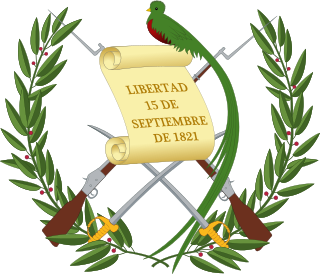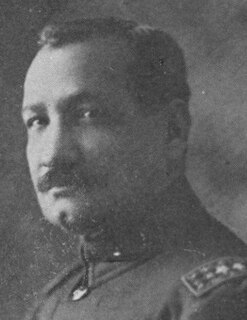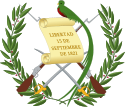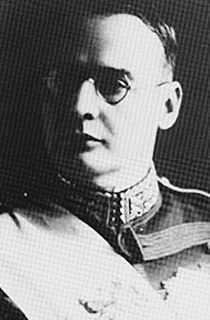
Jorge Ubico Castañeda, nicknamed Number Five or also Central America's Napoleon, was a Guatemalan dictator. A general in the Guatemalan army, he was elected to the presidency in 1931, in an election where he was the only candidate. He continued his predecessors' policies of giving massive concessions to the United Fruit Company and wealthy landowners, as well as supporting their harsh labor practices. Ubico has been described as "one of the most oppressive tyrants Guatemala has ever known" who compared himself to Adolf Hitler. He was removed by a pro-democracy uprising in 1944, which led to the ten-year Guatemalan Revolution.
A presidential election was held in Guatemala on 17–19 December 1944. The October Revolution of 1944 had overthrown Jorge Ubico, the U.S. backed dictator of Guatemala. A junta composed of Francisco Javier Arana, Jacobo Árbenz and Jorge Toriello took power, and quickly announced presidential elections, as well as elections for a constituent assembly. The subsequent elections took place in December 1944, and were broadly considered free and fair, although only literate men were given the vote. Unlike in similar historical situations, none of the junta members stood for election. The front-runner was the philosophically conservative University professor Juan José Arévalo, of the Renovación Nacional. Arévalo's closest challenger was Adrián Recinos, whose campaign included a number of individuals identified with the Ubico regime. The ballots were tallied on 19 December 1944, and Arévalo won in a landslide, receiving more than four times as many ballots as the other candidates combined.

General elections were held in Guatemala between 6 and 8 February 1931. In the presidential election Jorge Ubico was elected unopposed, after the remaining sector of the old Liberal Party did not object to his candidacy, whilst the Conservative Party was too disorganised and discredited from the Lázaro Chacón González era to put forward a candidate. Ubico's Progressive Liberal Party, formed by a union of the two wings of the divided Liberal Party also won the parliamentary election unopposed.

A referendum on the presidential term of Jorge Ubico was held in Guatemala on 25 May 1935. If approved, it would allow Ubico to override the constitutional limitation on serving two consecutive terms in office. It was reportedly approved by 99.85% of voters.

A presidential election was held in Guatemala on 15 December 1921.

Presidential elections were held in Guatemala during seven days in September 1898. Prior to the elections Manuel Estrada Cabrera had established the first real political party in the country's history by admitting people from outside the influential liberals to the Liberal Party.

Presidential elections were held in Guatemala in July 1904. The result was a victory for Manuel Estrada Cabrera, who received all but three of the national votes. He assumed the presidency on 15 March 1905.

Presidential elections were held in Guatemala on 11 April 1910. Manuel Estrada Cabrera was re-elected unopposed. He assumed the presidency on 15 March 1911.

Presidential elections were held in Guatemala on 17 January 1916. For the second successive election, Manuel Estrada Cabrera was re-elected unopposed. Despite there only being one candidate, voters were rounded up by the military and taken to polling stations, where they could only vote for Cabrera. Cabrera assumed the presidency on 15 March 1911.

Presidential elections were held in Guatemala on 27 August 1920. The result was a victory for Carlos Herrera y Luna, who received 95% of the vote.

Indirect presidential elections were held in Guatemala on 8 April 1920. After two decades of repression and dictatorial rule, political opponents of Manuel Estrada Cabrera organized the Unionist Party (PU) in 1919. Led by Conservatives tied to the landed oligarchy, the Unionists also attracted support among the urban proletariat, artisans, students, and industrialists.

Presidential elections were held in Guatemala on 22 February 1922. The result was a victory for José María Orellana, although the military had controlled the election and silenced the opposition, as well as putting down rebellions in at least twelve places including Antigua. Orellana assumed the presidency on 4 March.

Parliamentary elections were held in Guatemala in December 1925. The result was a victory for the Liberal Party, which won all 69 seats. The party faced serious opposition in only fifteen constituencies. In Guatemala City the Liberal received 3,289 votes, the Progressive Liberal Party 506 and the Conservative Party 178. The PLP claimed that they had won 90% of the vote, but that the Liberal government had discounted votes against them.

Parliamentary elections were held in Guatemala in December 1923. The result was a victory for the Liberal Party, which won all 69 seats. Liberal candidates won overwhelming victories in every constituency, a result that the American diplomatic corps described as farcical.

Constitutional Convention elections were held in Guatemala in June 1927. Lázaro Chacón González put 33 senior officers on the official list of candidates, and whilst civilian leaders of the Liberal Party were also on it, the fact that most of them were members of the armed forces suggested that González was determined to dominate the Convention.
Federico Hernández de León was a Guatemalan writer, historian and journalist. He graduated from the Instituto Nacional Central para Varones of Guatemala, with a high school diploma in 1900. Active politically, was arrested during the last few years of the government of president Manuel Estrada Cabrera, being held in the Central Penitentiary of Guatemala until the president was deposed on April 14, 1920. After his release, he went straight to take over the Diario de Centro América semi-official newspaper of Guatemala at the time. Later, he directed Nuestro Diario along with Carlos Bauer Aviles.

Manuel María Orellana Contreras was a Guatemalan army officer and politician, and from 17 to 31 December 1930, de facto interim President of Guatemala, after leading a coup d'état that ended Baudilio Palma interim presidency. Palma, in turn, had been appointed president only four days earlier, when president Lázaro Chacón González suffered a stroke and was forced to resign. At the moment the coup took place, orellana Contreras was commander of the San Rafael de Matamoros Fort in Guatemala City.

Presidential elections were held in Guatemala in November 1873. Justo Rufino Barrios wins the presidency.

Presidential elections were held in Guatemala in November 1880.












